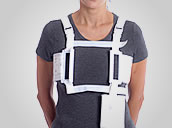
The Set-Up Process
Getting the Heart Hugger on and ready to use is simple. Most patients will need the assistance of a nurse or loved one to assist, but putting it on is easy and quick. It’s best to try on and adjust the Heart Hugger before the operation so it’s ready to go right after surgery. Details on how to correctly size and fit Heart Hugger can be found on our sizing and fitting page. Similar to a vest or backpack, you put the Heart Hugger on one arm at a time. Here are the quick steps for helping a patient get situated in a Heart Hugger:

- Detach the shoulder strap from the handle on one side and slide the handle under the patient’s arm. Bring the shoulder strap over the shoulder and reattach it. Repeat this process on the other arm.
- Adjust the straps around the chest as needed so the handles are one hand-width apart for the patient so they can easily grasp them together single-handedly.
- Adjust the straps over the shoulders so the fit is comfortable and the handles rest on the patient mid-chest.
- Fasten the velcro retention strap to keep the handles in place.
When to Use the Heart Hugger
Once the patient is situated, they can use the Heart Hugger whenever they cough, sneeze or make movements that are strenuous or uncomfortable. The encircling support provides relief when moving or breathing deeply.
Adjustments for Women
On women, the Heart Hugger can fit a bit differently depending on stature and breast size. Heart Hugger can be adjusted easily to accommodate different body types. Handles should be adjusted to set just above the breasts with the handles remaining as parallel as possible. To accomplish this, angle the wide chest strap at a slight upward angle from back to front and use the retention strap to keep the handles situated.
If the patient finds the device binding under the armpits, the chest strap can be moved down the back further keeping the angle point upward and the handles on top of the breasts. The handles may flare out a bit at the bottom, which is fine so long as the patient can still grasp both handles with one hand.
To discuss sternal support options,
